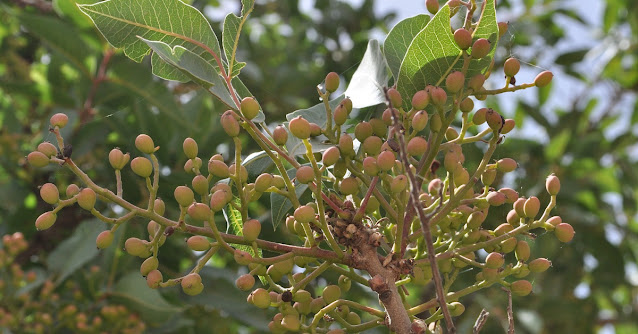यो पश्चिम हिमालका लेकतिर २००० मिटरसम्म उचाइमा
४०-५० फिट अग्लो
पतझर रूख केही मोटो
हुन्छ। यो चैत्रमा फूल
र साउनमा फल पाक्दछ ।
यसको पात / भेट्नुमा गाँठो रहन्छ र यसैलाई कीराको
गुँड भनी प्रयोग गर्ने
चलन छ । यसको
उपयोगिता रुघा, खोकी, ज्वर, दम, आउँ र
पौष्टिकताका लागि गरिन्छ ।
मात्रा : ३-५ ग्राम
२-३ पटक ।
परिचय
भाले काकरसिङ्गी (Pistacia khinjuk) एक प्रकारको औषधीय रूख हो जुन पिस्टासिया (Pistacia) परिवारमा पर्छ। यो रूख पश्चिमी हिमालय क्षेत्रमा पाइन्छ र यसको औषधीय गुणका कारण यसलाई धेरै वर्षदेखि पारम्परिक चिकित्सामा प्रयोग गरिँदै आएको छ। यसको वानस्पतिक नाम Pistacia khinjuk हो। यो रूख नेपाल, भारत, पाकिस्तान, अफगानिस्तान, इरान, इराक लगायतका देशहरूमा पाइन्छ। यसको पात, फल,
नेपाल र अन्य देशहरूमा
उपलब्धता
भाले
काकरसिङ्गी नेपालको पश्चिमी हिमालय क्षेत्रमा २००० मिटरसम्मको उचाइमा
पाइन्छ। यो रूख नेपालका
साथै भारत, पाकिस्तान, अफगानिस्तान, इरान, इराक, तुर्की, र मध्य एसियाका
केही देशहरूमा पनि पाइन्छ। यो
रूख प्रायः पहाडी क्षेत्रहरूमा पाइन्छ र यसको प्राकृतिक
वातावरणमा यसको उत्पादन हुन्छ।
नेपालमा यो रूख धेरैजसो
जंगलमा प्राकृतिक रूपमा उम्रन्छ र यसको औषधीय
प्रयोगका लागि यसलाई स्थानीय
मानिसहरूले संग्रह गर्छन्।
भौतिक गुणहरू
भाले
काकरसिङ्गीको रूख ४०-५०
फिट अग्लो हुन्छ र यो पतझर
प्रजातिको रूख हो। यसको
बोट मोटो हुन्छ र
यसको पातहरू साना र गोलाकार
हुन्छन्। यसको पातमा गाँठो
हुन्छ जसलाई स्थानीय भाषामा "कीराको गुँड" भनिन्छ। यसको फूल चैत्र
महिनामा फुल्छ र फल साउन
महिनामा पाक्छ। यसको फल सानो
र गोलाकार हुन्छ र यसमा धेरै
औषधीय गुणहरू हुन्छन्।
औषधीय गुणहरू
भाले
काकरसिङ्गीमा धेरै औषधीय गुणहरू
पाइन्छन्। यसको पात, फल,
र छालामा एन्टी-इन्फ्लामेटरी, एन्टी-ब्याक्टेरियल, एन्टी-फंगल, र एन्टी-ओक्सिडन्ट
गुणहरू पाइन्छन्। यसले रोग प्रतिरोधक
क्षमता बढाउन मद्दत गर्छ र शरीरलाई
पौष्टिक तत्वहरू प्रदान गर्छ। यसको प्रयोगले रुघाखोकी,
ज्वरो, दम, आउँ, र
अन्य पाचन समस्याहरूको उपचारमा
मद्दत गर्छ।
फाइदाहरू
भाले
काकरसिङ्गीको प्रयोगले धेरै स्वास्थ्य सम्बन्धी
फाइदाहरू प्रदान गर्छ। यसले शरीरलाई पौष्टिक
तत्वहरू प्रदान गर्छ र रोग
प्रतिरोधक क्षमता बढाउँछ। यसले श्वासप्रश्वास सम्बन्धी
समस्याहरू जस्तै रुघाखोकी, दम, र अस्थमाको
उपचारमा मद्दत गर्छ। यसले पाचन तन्त्रलाई
मजबूत बनाउँछ र आउँ र
अन्य पाचन समस्याहरूको उपचारमा
मद्दत गर्छ। यसले ज्वरो कम
गर्छ र शरीरलाई ठण्डा
राख्छ।
प्रयोग विधि
भाले
काकरसिङ्गीको प्रयोग धेरै तरिकाले गर्न
सकिन्छ। यसको पात, फल,
र छालालाई पानीमा उमालेर काढा बनाएर प्रयोग
गर्न सकिन्छ। यसको काढा दिनमा
२-३ पटक ३-५ ग्रामको मात्रामा
सेवन गर्न सकिन्छ। यसको
पातलाई पानीमा उमालेर वा सुकाएर पनि
प्रयोग गर्न सकिन्छ। यसको
फललाई सुकाएर पनि प्रयोग गर्न
सकिन्छ। यसको प्रयोग गर्दा
मात्रा नियन्त्रित गर्नुपर्छ किनभने धेरै मात्रामा सेवन
गर्दा केही साइड इफेक्ट
हुन सक्छ।
संग्रह र संरक्षण
भाले
काकरसिङ्गीको पात, फल, र
छालालाई संग्रह गर्न उचित समयमा
गर्नुपर्छ। यसको पात र
फल चैत्र र साउन महिनामा
संग्रह गर्न उपयुक्त हुन्छ।
यसलाई संग्रह गरेपछि सुकाएर संरक्षण गर्नुपर्छ। यसलाई सुकाएर एयरटाइट कन्टेनरमा राख्नुपर्छ र ठूलो समयसम्म
प्रयोग गर्न सकिन्छ। यसलाई
सुकाउन उचित तापक्रम र
सूर्यको प्रकाश आवश्यक छ।
निष्कर्ष
भाले
काकरसिङ्गी एक महत्त्वपूर्ण औषधीय
रूख हो जसले धेरै
स्वास्थ्य सम्बन्धी फाइदाहरू प्रदान गर्छ। यसले रोग प्रतिरोधक
क्षमता बढाउन मद्दत गर्छ र धेरै
रोगहरूको उपचारमा प्रयोग गरिन्छ। यसको प्रयोग गर्दा
मात्रा नियन्त्रित गर्नुपर्छ र उचित समयमा
संग्रह गरेर संरक्षण गर्नुपर्छ।
यसले प्राकृतिक रूपमा धेरै स्वास्थ्य समस्याहरूको
उपचारमा मद्दत गर्छ र यसको
प्रयोगले शरीरलाई पौष्टिक तत्वहरू प्रदान गर्छ। यसरी भाले काकरसिङ्गीले
मानव जीवनमा महत्त्वपूर्ण भूमिका खेल्छ र यसको प्रयोगले
स्वस्थ जीवनशैली बनाउन मद्दत गर्छ।
Introduction
Pistacia khinjuk, commonly known as Bhale Kakarsinghi in
Nepal, is a deciduous tree belonging to the Anacardiaceae family. This species
is native to regions extending from the Mediterranean to Western Asia,
including countries like Iran, Afghanistan, and parts of the Indian
subcontinent. In Nepal, it is referred to as भाले
काकरसिङ्गी or कर्कट. The tree is notable
for its medicinal properties, particularly the galls formed on its leaves,
which have been utilized in traditional medicine for centuries.
Availability in Nepal and Other Countries
In Nepal, Bhale Kakarsinghi thrives in the western Himalayan
regions, typically at elevations up to 2,000 meters. The tree prefers rocky and
well-drained soils, often found in forested areas and hillsides. Beyond Nepal,
Pistacia khinjuk is prevalent in countries such as Iran, Afghanistan, Pakistan,
and India. Its adaptability to various climatic conditions allows it to grow in
both temperate and semi-arid regions, making it a resilient species across its
native range.
Physical Properties
Pistacia khinjuk is a deciduous tree that can reach heights
of 40 to 50 feet. It has a sturdy trunk with rough, grayish-brown bark. The
leaves are compound, pinnate, and alternately arranged, with each leaf
comprising multiple leaflets. A distinctive feature of this tree is the
formation of galls on its leaves and petioles. These galls, known as
Kakarsinghi, are horn-shaped structures resulting from the activity of specific
insects. They are greenish-brown to brown in color, hard, and hollow, measuring
between 3 to 10 centimeters in length and 1 to 5 centimeters in width. The tree
blossoms in the spring (Chaitra), producing small, inconspicuous flowers, and
the fruits mature by the monsoon season (Saun).
Medicinal Properties
The galls of Pistacia khinjuk are rich in tannins and
possess various medicinal properties:
- Antimicrobial:
The tannin content exhibits antibacterial and antifungal activities,
aiding in the treatment of infections.
- Anti-inflammatory:
Compounds present in the galls help reduce inflammation, making them
useful in treating respiratory conditions.
- Antioxidant:
The galls contain antioxidants that combat free radicals, contributing to
overall health.
- Astringent:
Their astringent properties make them effective in treating diarrhea and
dysentery.
Advantages and Uses
Bhale Kakarsinghi has been traditionally used for various
ailments:
- Respiratory
Issues: It is commonly used to treat coughs, colds, asthma, and
bronchitis due to its expectorant and anti-inflammatory properties.
- Fever:
The galls are utilized to reduce fever and associated symptoms.
- Digestive
Disorders: Their astringent nature helps in managing diarrhea and
dysentery.
- Nutritional
Supplement: The galls are considered to have nutritive properties,
enhancing overall health and vitality.
Using Methods
The galls can be used in various forms:
- Powder:
Dried galls are ground into a fine powder. The recommended dosage is 3-5
grams, taken 2-3 times daily.
- Decoction:
Boiling the galls in water to extract their active compounds, consumed to
alleviate respiratory and digestive issues.
- Paste:
A paste made from the powdered galls can be applied externally to treat
skin conditions and inflammations.
Harvesting and Preservation
The galls are typically harvested during the monsoon season
when they are fully developed. Harvesting involves collecting the galls from
the leaves and petioles without damaging the tree. After collection, they are
cleaned and dried thoroughly in a shaded, well-ventilated area to prevent mold
growth. Once dried, the galls are stored in airtight containers, protected from
moisture and direct sunlight, to preserve their medicinal properties.
Conclusion
Pistacia khinjuk, or Bhale Kakarsinghi, holds significant
value in traditional medicine, particularly in Nepal and surrounding regions.
Its galls are esteemed for their diverse medicinal properties, offering natural
remedies for respiratory, digestive, and inflammatory conditions. Sustainable
harvesting and proper preservation of these galls ensure the continued
availability of this valuable natural resource, contributing to the health and
well-being of communities that rely on traditional medicinal practices.
दतिवन Washerman’s Plant (Achyranthes aspera अपामार्ग): Benefits, Uses, and Medicinal Properties
Kooth (Saussurea Lappa) – कूठ Benefits, Uses, and Medicinal Properties of Costus Root
काने झार Commeline Benghalensis (Kane Jhaar) – Medicinal Uses, Benefits, and Overview
गिँदरी Premna Serratifolia L. (Gindari): Benefits, Medicinal Uses, and Importance
पाञ्चान Ougeinia oojeinensis (Paanchan): तिनिश Medicinal Uses, Benefits, and Ecological Importance
बोके टिमुर Zanthoxylum Armatum (Boke Timur) Benefits, Uses, and Medicinal Properties
ठूलो नीम Thulo Neem: महारूख Medicinal Benefits, Uses, and Natural Remedies
सिउँडी Siudi (Euphorbia Neriifolia) Uses, Benefits, Side Effects, and Medicinal Properties
काठेकार, फर्कफल, काठआँवली, Averrhoe acida :
Kaaulo, काउलो, कोह, नाकेम, नेपाली अर्जुन, Kaulo Arjuna, Machilus dutbiei
Kaalo Punarnawaa, कालो पुनर्नवा, Black Patagon
Seti Kareli, सेती करेली, तितेकरेली राम्री, तिताकरेल, Bitter Gourd
Thulo Pahelo Kapaas, ठूलो पहेँलो कपास बिरुवा, Cotton Yellow, Gossypiun birsutam
Kapas, कपास, सूत्रपुष्प, Cotton, Gossypiun herbaceum
Thulo Karkalo, ठूलो कर्कलो, मानकन्द, माने Gaint Taro, Alocaria species
Alocaria speciesThulo Karkaloठूलो कर्कलोमानकन्दमाने Gaint Taro
Katahar, कटहर, Artocarpus beterophyllus
Bans Bata Baneko Kaagaj, बाँसबाट बनेको कागज, Paper From Bamboo
Nepali Speaking Practice through Books in Hindi and English
Master Hindi Speaking Through Indian Schools: Practical Phrases with Nepali and English Translations
Master Hindi Speaking with Indian Railways: Practical Phrases with Nepali and English Translations
Learn Nepali with Mobile Phone Conversations including Hindi and English Translations
Master Hindi Speaking: Practice Through Movie information with Nepali and English Translations
Famous poem Of Upendra Subba उपेन्द्र सुब्बाका केही कबिताहरु
Some Top poem of Pandit Udayananda Aryal पं. उदयानन्द अर्ज्यालका केही कबिताहरु
Some Top Poem Of Ishwar Ballav, ईश्वरवल्लभका केही चर्चित कबिताहरु
Some Best Poem of Indira Prasai इन्दिरा प्रसाईका केही कबिताहरु
Some Best Poem Of Aahuti आहुतिका केही कबिताहरु
Some Beautiful Poem Of Momila मोमिलाका केही उत्कृष्ट कबिताहरु
Top Ten Poems Of R M Dangol आर. एम. डङ्गोल का केही कबिताहरु
Some Beautiful Poem Of Ashesh Malla अशेष मल्लका केही कबिताहरु
Some Best Poem Of Ambar Gurung अम्बर गुरुङका केही कबिताहरु
Top Ten Poems Of Amar Giri अमर गिरीका १० कबिताहरु
Some Best Poem Of Kedarman vyathit केदारमान व्यथितका केही कबिताहरु
Chhapakkai Phula PHulyo Nepali Song By Singers Kiran Gajmer, Melina Rai
Kunai Batoa Timi Yeklai -BY singers Itu Jojiju, Ram Bhakta Jojiju
Maaya Raichha Ra By singer Kali Prasad Baskota, Sadeekshya Kattel
Manoj Raj Songs Lyrics "Kaliyug Ma Nasha" "Aaja Bholi" "Yasto Euta Katha Raichha"
Nepali Lyrics Of Unko Priti Pahile Ho Ki By Singer : Prabin Bedwal, Rachana Rimal
Nira Singer : Kali Prasad Baskota
Rabin Sharma Top songs lyrics and chords collection
Sanjeev Singh All Hits songs lyrics and chords collection
Top three Song Lyrics Of Sukmit Gurung "Pal Pal Timrai" "O Mero Priyatam" "Chiso Batas Le"
























